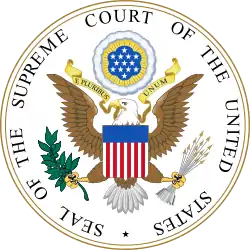Carroll v. United States (1957)
Carroll v. United States, 354 U.S. 394 (1957),[1] was a case dealing with the appealablility of a suppression order issued by the Federal District Court for the District of Columbia for an unlawful warrant under the Fourth Amendment.
| Carroll v. United States | |
|---|---|
 | |
| Argued April 4, 1957 Decided June 24, 1957 | |
| Full case name | Leon F. Carroll and Daniel J. Stewart v. United States |
| Citations | 354 U.S. 394 (more) 77 S. Ct. 1332; 1 L. Ed. 2d 1442 |
| Case history | |
| Prior | |
| Holding | |
| The order of suppression of evidence in this case by the District Court is not appealable under the statutes of the federal appeals courts; therefore, the appeal should've been dismissed. | |
| Court membership | |
| |
| Case opinion | |
| Majority | Warren, joined by unanimous |
In February of 1957, officers arrested Carroll and Stewart on John Doe arrest warrants for violations of local lottery laws. During the detainment, officers conducted a Search Incident to Arrest and seized evidence from their person. They petitioned the District Court for suppression of the evidence on grounds that the warrants were null and void due to the lack of the Constitutionally required probable cause under the Fourth Amendment to the U.S. Constitution.[2] The District Court granted the petition. The Government appeals to the Federal Court of Appeals, which reversed the suppression order.
In a unanimous 9-0 opinion written by Justice Warren, the Supreme Court of the United States reversed the Court of Appeals, stating that:
𝐼𝑡 𝑖𝑠 𝑎𝑥𝑖𝑜𝑚𝑎𝑡𝑖𝑐, 𝑎𝑠 𝑎 𝑚𝑎𝑡𝑡𝑒𝑟 𝑜𝑓 ℎ𝑖𝑠𝑡𝑜𝑟𝑦 𝑎𝑠 𝑤𝑒𝑙𝑙 𝑎𝑠 𝑑𝑜𝑐𝑡𝑟𝑖𝑛𝑒, 𝑡ℎ𝑎𝑡 𝑡ℎ𝑒 𝑒𝑥𝑖𝑠𝑡𝑒𝑛𝑐𝑒 𝑜𝑓 𝑎𝑝𝑝𝑒𝑙𝑙𝑎𝑡𝑒 𝑗𝑢𝑟𝑖𝑠𝑑𝑖𝑐𝑡𝑖𝑜𝑛 𝑖𝑛 𝑎 𝑠𝑝𝑒𝑐𝑖𝑓𝑖𝑐 𝑓𝑒𝑑𝑒𝑟𝑎𝑙 𝑐𝑜𝑢𝑟𝑡 𝑜𝑣𝑒𝑟 𝑎 𝑔𝑖𝑣𝑒𝑛 𝑡𝑦𝑝𝑒 𝑜𝑓 𝑐𝑎𝑠𝑒 𝑖𝑠 𝑑𝑒𝑝𝑒𝑛𝑑𝑒𝑛𝑡 𝑢𝑝𝑜𝑛 𝑎𝑢𝑡ℎ𝑜𝑟𝑖𝑡𝑦 𝑒𝑥𝑝𝑟𝑒𝑠𝑠𝑙𝑦 𝑐𝑜𝑛𝑓𝑒𝑟𝑟𝑒𝑑 𝑏𝑦 𝑠𝑡𝑎𝑡𝑢𝑡𝑒. [3]
The Court held that, although some orders may be appealable under the authority of 18 U.S.C. 1291, this order in this case lacked such authority. The Circuit Court was reversed and remanded.
References
- "Carroll vs. United States, 1957". Oyez.
- 𝑇ℎ𝑒 𝑅𝑖𝑔ℎ𝑡 𝑜𝑓 𝑡ℎ𝑒 𝑃𝑒𝑜𝑝𝑙𝑒 𝑡𝑜 𝑏𝑒 𝑠𝑒𝑐𝑢𝑟𝑒 𝑖𝑛 𝑡ℎ𝑒𝑖𝑟 𝑝𝑒𝑟𝑠𝑜𝑛𝑠, ℎ𝑜𝑢𝑠𝑒𝑠, 𝑝𝑎𝑝𝑒𝑟𝑠, 𝑎𝑛𝑑 𝑒𝑓𝑓𝑒𝑐𝑡𝑠, 𝑎𝑔𝑎𝑖𝑛𝑠𝑡 𝑢𝑛𝑟𝑒𝑎𝑠𝑜𝑛𝑎𝑏𝑙𝑒 𝑠𝑒𝑎𝑟𝑐ℎ𝑒𝑠 𝑎𝑛𝑑 𝑠𝑒𝑖𝑧𝑢𝑟𝑒𝑠, 𝑠ℎ𝑎𝑙𝑙 𝑛𝑜𝑡 𝑏𝑒 𝑣𝑖𝑜𝑙𝑎𝑡𝑒𝑑; 𝒂𝒏𝒅 𝒏𝒐 𝒘𝒂𝒓𝒓𝒂𝒏𝒕𝒔 𝒔𝒉𝒂𝒍𝒍 𝒊𝒔𝒔𝒖𝒆, 𝒃𝒖𝒕 𝒖𝒑𝒐𝒏 𝒑𝒓𝒐𝒃𝒂𝒃𝒍𝒆 𝒄𝒂𝒖𝒔𝒆, 𝑠𝑢𝑝𝑝𝑜𝑟𝑡𝑒𝑑 𝑏𝑦 𝑜𝑎𝑡ℎ 𝑜𝑟 𝑎𝑓𝑓𝑖𝑟𝑚𝑎𝑡𝑖𝑜𝑛, 𝑎𝑛𝑑 𝑝𝑎𝑟𝑡𝑖𝑐𝑢𝑙𝑎𝑟𝑙𝑦 𝑑𝑒𝑠𝑐𝑟𝑖𝑏𝑖𝑛𝑔 𝑡ℎ𝑒 𝑝𝑙𝑎𝑐𝑒 𝑡𝑜 𝑏𝑒 𝑠𝑒𝑎𝑟𝑐ℎ𝑒𝑑, 𝑎𝑛𝑑 𝑡ℎ𝑒 𝑝𝑒𝑟𝑠𝑜𝑛𝑠 𝑜𝑟 𝑡ℎ𝑖𝑛𝑔𝑠 𝑡𝑜 𝑏𝑒 𝑠𝑒𝑖𝑧𝑒𝑑. The Fourth Amendment.
- Carroll v. United States, 354 U.S. 394 (1957).
External links
- Text of Carroll v. United States, 354 U.S. 394 (1957) is available from: CourtListener Justia Library of Congress Oyez (oral argument audio)